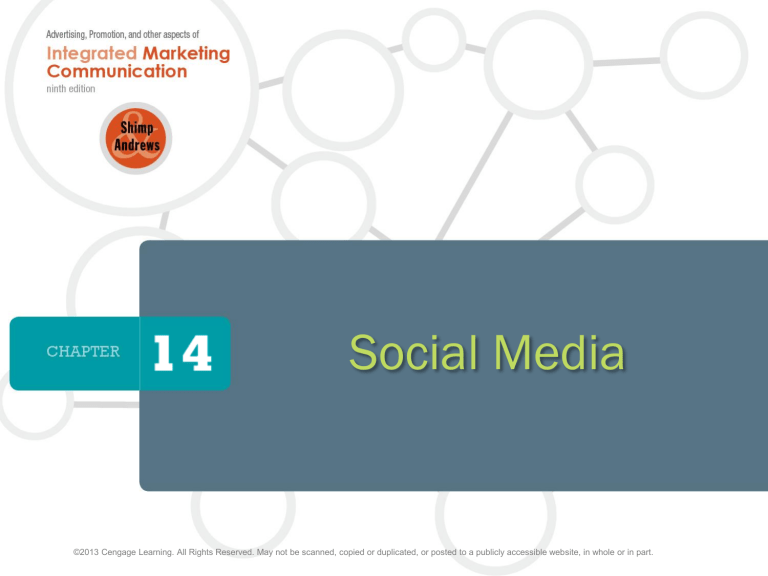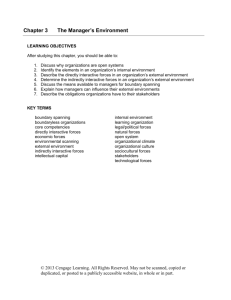
1
Social Media
©2013 Cengage Learning. All Rights Reserved. May not be scanned, copied or duplicated, or posted to a publicly accessible website, in whole or in part.
Chapter Objectives
After reading this chapter you should be able to:
1. Describe what exactly is meant by “social media.”
2. Discuss the advantages of social media compared
to traditional media choices.
3. Explain some of the major social media categories
and different social media brands (e.g., Facebook,
Twitter, Google+, LinkedIn) within those
categories (e.g., Communication-social
networking).
©2013 Cengage Learning. All Rights Reserved. May not be scanned, copied or duplicated, or posted to a publicly accessible website, in whole or in part.
2
Chapter Objectives (cont’d)
4. Provide examples of some successful social media
campaigns and how these were integrated into a
company’s IMC efforts.
5. Explain the privacy issues and other major
concerns with social media.
6. Understand how social media effectiveness is best
measured and what metrics are used.
©2013 Cengage Learning. All Rights Reserved. May not be scanned, copied or duplicated, or posted to a publicly accessible website, in whole or in part.
3
Is Facebook Becoming Passé?
©2013 Cengage Learning. All Rights Reserved. May not be scanned, copied or duplicated, or posted to a publicly accessible website, in whole or in part.
4
Social Media
• Social media: web-based and mobile
technology used to turn communication
into interactive dialogue.
• Integrates technology and social interactions
to create value for users
• Helps to solve consumer problems by
establishing communication
©2013 Cengage Learning. All Rights Reserved. May not be scanned, copied or duplicated, or posted to a publicly accessible website, in whole or in part.
5
Figure 14.1: Social Media Landscape
©2013 Cengage Learning. All Rights Reserved. May not be scanned, copied or duplicated, or posted to a publicly accessible website, in whole or in part.
6
Comparisons with Traditional Media
• Reach
• Both offer scale, but traditional media is more centralized, while social
media is decentralized
• Usability
• Traditional media requires specialized skills and training
• Anyone with online access can generate content for social media
• Immediacy
• Traditional media often has long time lags
• Social media can be generated very quickly
• Permanence
• Once created, traditional media cannot be altered
• Changes can be made “on the fly” with social media
©2013 Cengage Learning. All Rights Reserved. May not be scanned, copied or duplicated, or posted to a publicly accessible website, in whole or in part.
7
Social Media Advantages and Disadvantages
Flexibility
Privacy and censorship
Reach
Consumer engagement
Lost productivity,
addiction, and fatigue
Two-way dialogue
Meaningless comments
Integration
Hackers and frauds
Improved metrics
Negative comments
Cost effectiveness
©2013 Cengage Learning. All Rights Reserved. May not be scanned, copied or duplicated, or posted to a publicly accessible website, in whole or in part.
8
Ranking of Social Media Sites by Alexa
©2013 Cengage Learning. All Rights Reserved. May not be scanned, copied or duplicated, or posted to a publicly accessible website, in whole or in part.
9
Facebook
• Social network service and website launched in 2004
• Over 1 billion active users (2012); 182 million in the U.S. (In comparison, the 2012
Super Bowl audience was 111 million.)
• $3.7 billion in revenue
• “Write the Future” video initially launched 5/20/10 only on Facebook – 9 million
views; > 21 million views on YouTube
• Engagement ads live on the right side of the Facebook page, footnoted by names of
friends who have “liked” or interacted with the ad. If a member “likes” the brand,
future company ads/messages might appear insider the member’s newsfeed at no
extra cost to the advertiser.
• One-half of Facebook users check their site every day. Yet, click-throughs on
Facebook ads are only .1% (vs. Google - up to 10%). However, if a user sees a friend
“likes” an ad, they are 30% more likely to recall the ad’s message.
• Privacy issues – Facebook Places, apps
See Stone, Brad (2010), “Sell Your Friends (How Facebook Sells You),” Bloomberg Businessweek, Sept. 27, pp.
64-72.
©2013 Cengage Learning. All Rights Reserved. May not be scanned, copied or duplicated, or posted to a publicly accessible website, in whole or in part.
10
Figure 14.2: Share of Time Spent on
Facebook.com by Content Section
©2013 Cengage Learning. All Rights Reserved. May not be scanned, copied or duplicated, or posted to a publicly accessible website, in whole or in part.
11
Twitter
• Website established in 2006 offering social networking and
micro-blogging, enabling users to send tweets – text-based
posts up to 140 characters and displayed on the user's profile
page. Users may subscribe to other author tweets – known as
a following and subscribers known as followers.
• $140 million in revenue (2010); 500 million visitors (monthly) (April
2012)
• Late in 2009, Twitter changed their prompt from “What are you doing?”
to “What’s Happening?
• Advertising: While Twitter does not display advertising,
advertisers can target users based on their history of tweets
and may quote tweets in ads directed specifically to the user.
Promoted tweets show up in Twitter search results; users can
retweet ads at no extra cost to the advertiser.
12
©2013 Cengage Learning. All Rights Reserved. May not be scanned, copied or duplicated, or posted to a publicly accessible website, in whole or in part.
Twitter Content
• Tweet contents: Content of 2,000 U.S. Tweets
according to Pear Analytics (Aug. 2009):
•
•
•
•
•
•
Pointless babble — 40%
Conversational — 38%
Pass-along value — 9%
Self-promotion — 6%
Spam — 4%
News — 4%
©2013 Cengage Learning. All Rights Reserved. May not be scanned, copied or duplicated, or posted to a publicly accessible website, in whole or in part.
13
Successful Social Media Campaigns:
Blendtec’s “Will It Blend”?
©2013 Cengage Learning. All Rights Reserved. May not be scanned, copied or duplicated, or posted to a publicly accessible website, in whole or in part.
14
Successful Social Media Campaigns:
Burger King’s “Subservient Chicken”
©2013 Cengage Learning. All Rights Reserved. May not be scanned, copied or duplicated, or posted to a publicly accessible website, in whole or in part.
15
Successful Social Media Campaigns:
Old Spice
©2013 Cengage Learning. All Rights Reserved. May not be scanned, copied or duplicated, or posted to a publicly accessible website, in whole or in part.
16
Successful Social Media Campaigns:
Common Objectives and Themes
• Sharing humor and creativity with
consumers
• Deals and contests
• Causes, sponsorships, and events
• Interactive games, virtual worlds, and
avatars
• Consumer-generated stories and content
©2013 Cengage Learning. All Rights Reserved. May not be scanned, copied or duplicated, or posted to a publicly accessible website, in whole or in part.
17
What Makes a Social Media Campaign
“Work” and Why
Encourage storytelling about the brand
• Co-produce messages and meanings with consumers
“Step into the real world”
• Connect and engage with customers through empathy,
understanding, and openness
Evolve with your customers in being social and human
• Admit mistakes and accept criticism
©2013 Cengage Learning. All Rights Reserved. May not be scanned, copied or duplicated, or posted to a publicly accessible website, in whole or in part.
18
Privacy and Other Concerns
• Privacy
• General Privacy Principles
• Notice
• Consent
• Access
• Security
• Facebook Privacy Policy
• Critics have voiced concern over Facebook’s privacy policy including the
use of location services, third-party data tracking, and allowing advertisers to
republish user posts
• Other Concerns
• Addiction
• Age of users
©2013 Cengage Learning. All Rights Reserved. May not be scanned, copied or duplicated, or posted to a publicly accessible website, in whole or in part.
19
Social Media Measurement:
comScore’s 2-million Social Essentials Panel
Impressions/Unique Exposed
Fans= Frequency
Total U.S. Reach x Frequency =
Total U.S. GRPs
©2013 Cengage Learning. All Rights Reserved. May not be scanned, copied or duplicated, or posted to a publicly accessible website, in whole or in part.
Unpaid Brand Impressions on Facebook
comScore Example
©2013 Cengage Learning. All Rights Reserved. May not be scanned, copied or duplicated, or posted to a publicly accessible website, in whole or in part.
21








